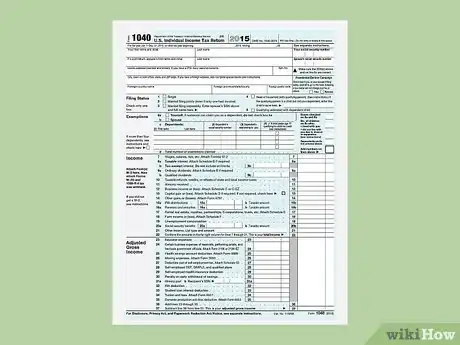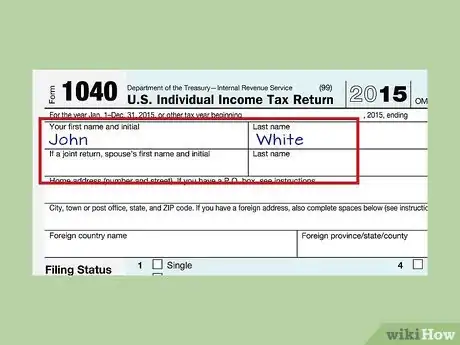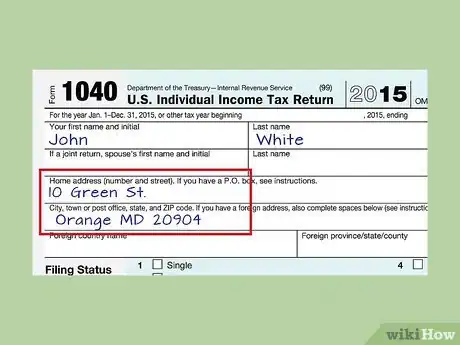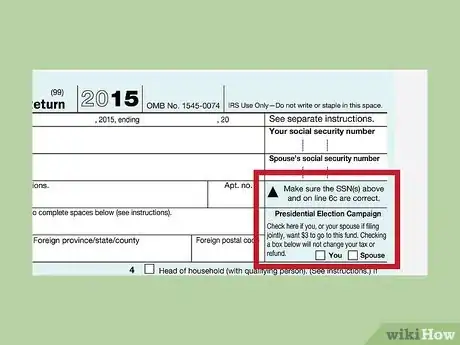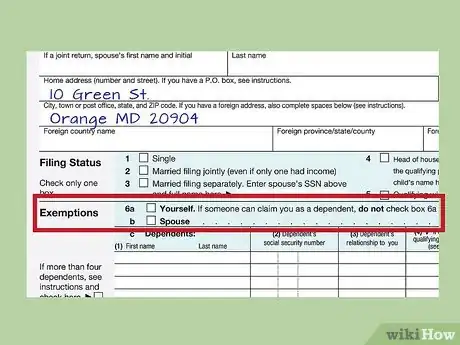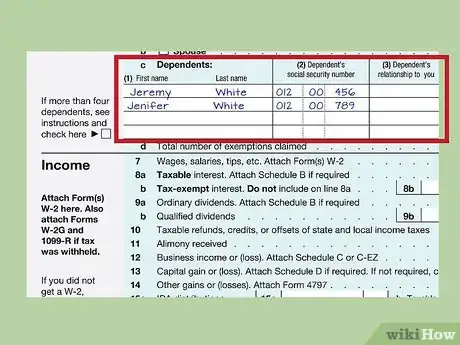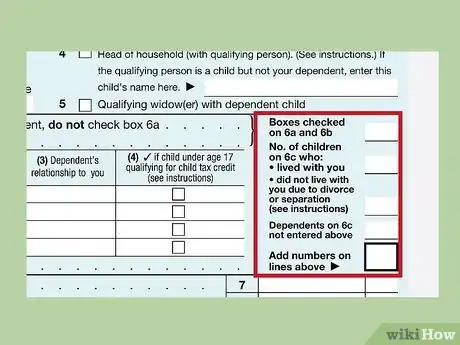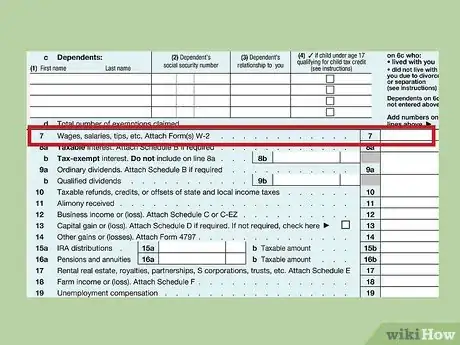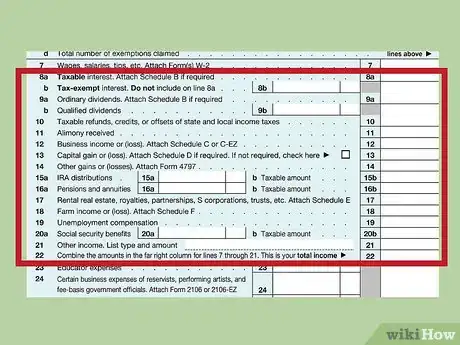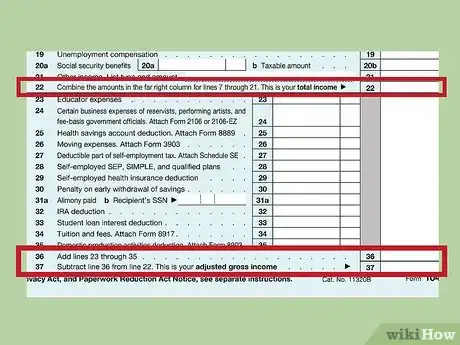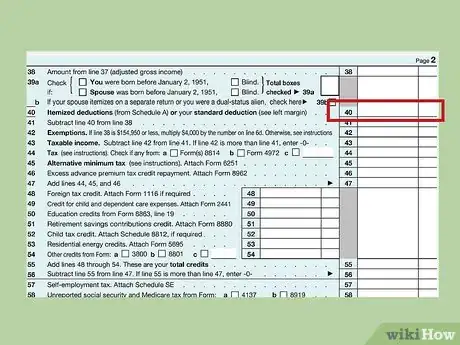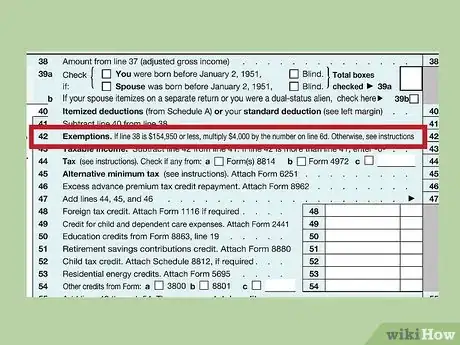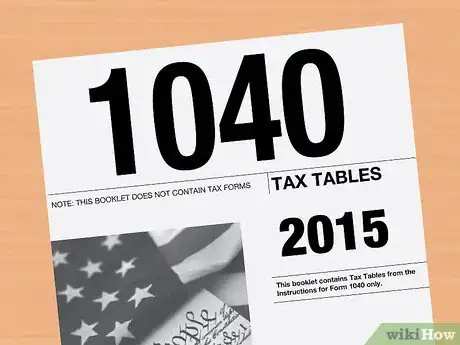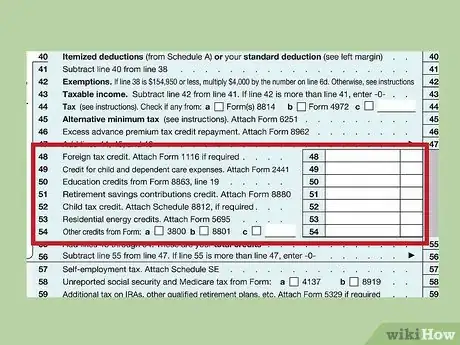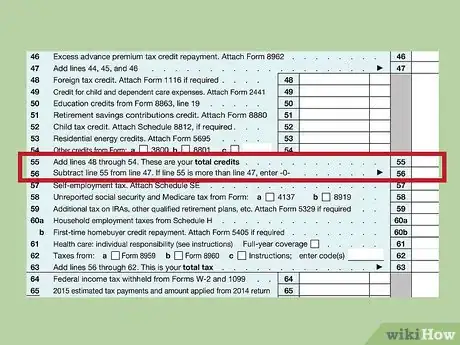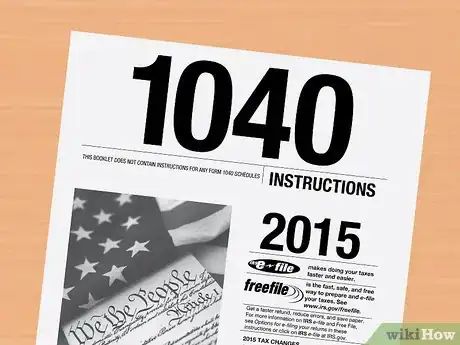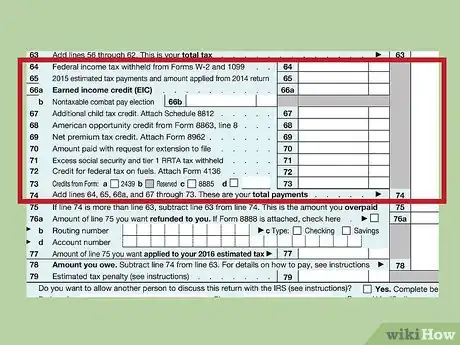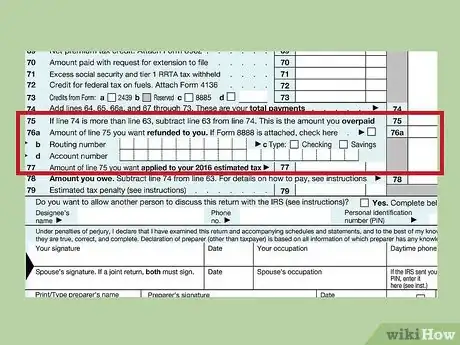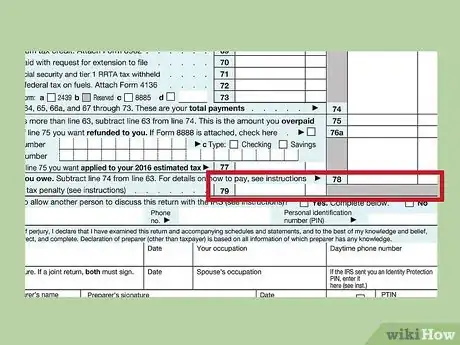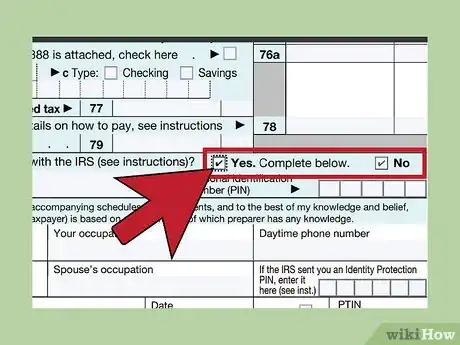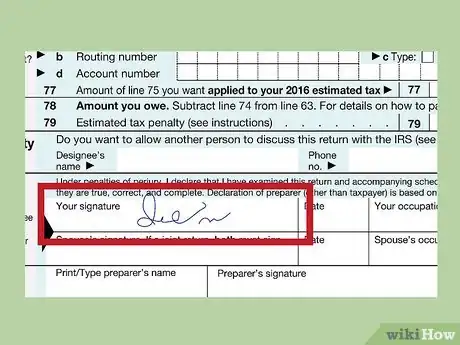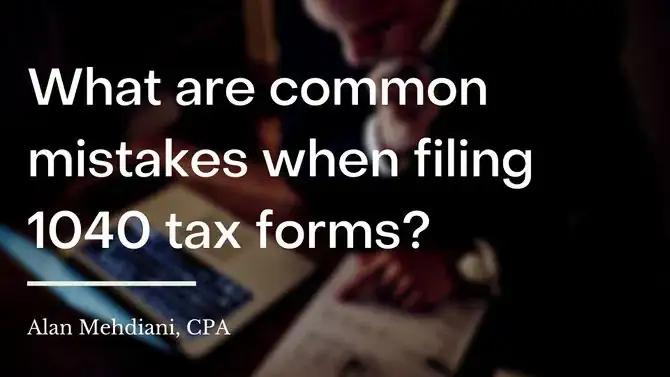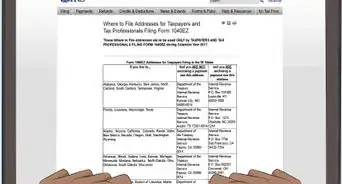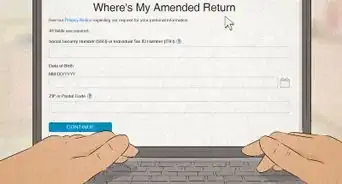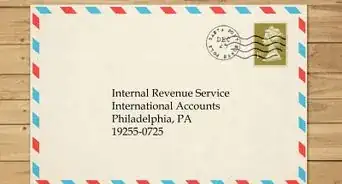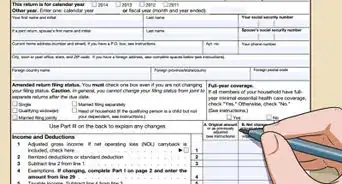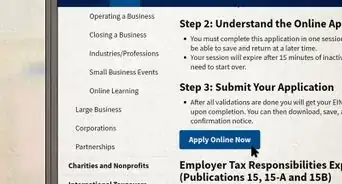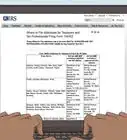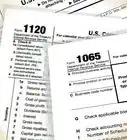This article was co-authored by John Gillingham, CPA, MA. John Gillingham is a Certified Public Accountant, the Owner of Gillingham CPA, PC, and the Founder of Accounting Play, Apps to teach Business & Accounting. John, who is based in San Francisco, California, has over 14 years of accounting experience and specializes in assisting consultants, bootstrapped startups, pre-series A ventures, and stock option compensated employees. He received his MA in Accountancy from the California State University - Sacramento in 2011.
There are 15 references cited in this article, which can be found at the bottom of the page.
This article has been viewed 490,055 times.
Most US citizens, and resident aliens, are required to file an individual tax return to the federal government every year. The basic form used for this is IRS Form 1040. Unlike Form 1040A and 1040EZ, both of which can only be used for specific types and levels of income, all taxpayers can use Form 1040 to report and file their annual taxes.[1] You should file your 1040 or a request for extension every year by April 15.
Steps
Preparing to Fill Out IRS Form 1040
-
1Locate the correct form. Form 1040 can be found on the IRS website.
- If you are required to complete other forms or schedules and attach them to Form 1040, this will be stated on the applicable line instructions. You will need to locate instructions for the referenced form or schedule to complete it. Forms for current and prior years can also be found on the IRS website.
-
2Determine if you are required to file income taxes. Basically, if your income is low enough, you are not required to file income taxes. Check the instructions in chart A, generally on page 7 of the instructions for Form 1040A for the current income thresholds. These vary depending on your filing status and are subject to change annually. Even if your income is below these thresholds, you are required to file taxes if any of the following apply:[2]
- You owe alternative minimum tax
- You owe additional tax on a qualified plan, such as an IRA
- You owe household employment taxes
- You owe Social Security and Medicare tax on unreported tips.
- You owe recapture taxes.
- You owe write-in taxes such as additional taxes on health savings accounts.
- You received HAS, Archer MSA, or Medicare Advantage MSA distributions.
- You had net earnings from self-employment of at least $400.
- You had wages of $108.28 or more from a church or church-controlled organization that is exempt from employer Social Security and Medicare taxes.
- Advance payments of the premium tax credit were made for you or any dependent enrolled through the Health Insurance Marketplace.
Advertisement -
3Decide whether you want to file income taxes, even if you are not required to. You may want to take the time to file so you can receive a refund of any taxes you have paid in throughout the year. Filing taxes will also allow you to take advantage of certain credits, such as the earned income credit, that are offered to low income taxpayers.
-
4Gather all information you will need to complete your taxes. This includes income documents, such as W-2 and 1099 forms. You will also need any other tax documentation that has been sent you, including records of taxable interest, Social Security benefits, and a variety of other forms (such as information on charitable giving, any documents on retirement contributions or disbursement).
- If this is a pain for you this year, start organizing your books for next year going forward! Keep all of your files and books together so that it’s easier to track everything when taxes come due.
Filling Out the Personal Information Section
-
1Fill in your personal information.[3] The primary taxpayer’s full name and Social Security Number will go on the top line. This should be your full, legal name, as matched to the records of both the Social Security Administration and the IRS taxpayer records.
- If you are married filing jointly, it does not matter which name goes on top, so long as you file the same way each year.
- If you are single, leave the second line blank.
-
2Fill in your address. If you have a PO address and a street address, use the street address. You should only use a PO address if your post office will not deliver mail to your home.
- If you live in a foreign country, fill in the information on the 5th line of the box. If you live in the United States, leave that information blank.
-
3Decide if you want to check the Presidential Election Campaign box. If you check the Presidential Election Campaign box (in the shaded area), $3 of your taxes will be put in a special fund and distributed to serious presidential candidates who agree to limit campaign spending and refuse private donations. You will pay the same amount in taxes either way.
- Checking this box does not increase or decrease your tax refund. The $3 is paid for by the government.
Filling Out the Filing Status and Exemptions Sections
-
1Choose your filing status. If more than one status could apply to you, choose the one that gives you the lowest tax liability. This is often, but not always, the status with the highest standard deduction amount.[4]
- If you are unmarried, or legally separated, on December 31 of the tax year and are not supporting another person in your household, choose “single”.
- If you are married, and you and your spouse are filing your taxes on the same form (even if only one of you has income), choose “married filing jointly”.
- If you are married, and you and your spouse are each filing individual, separate returns, choose “married filing separately”.
- If you are not married and supporting other people in your household, choose “head of household”. If that person is a child who is not your dependent for tax purposes, write that child’s name in the line beside the box.
- You can choose “qualifying widow(er) with dependent child” if your spouse died in the two years prior to the current tax year (but not in the current tax year), you have not remarried, you have a dependent child, you pay over half of the cost of maintaining your home, and you could have filed a joint return with your spouse on the year she or he died.
-
2Check exemption boxes for you and your spouse, if applicable, on lines 6 a-d. Unless you can be claimed on someone else’s taxes, check box 6a. Unless your spouse can be claimed on someone else’s taxes, check box 6b (if you have a spouse).
- Check the box for ‘spouse’ only if you are married according to the federal government's definition. Remember, for federal income tax purposes, "married" means a legal union with a person of the opposite sex. If you are married to a person of the same sex, you may be eligible to file your state taxes jointly but you cannot file joint federal tax returns.
-
3List your dependants’ information in the appropriate spaces in section 6c. List their first and last names, Social Security numbers, and the relationship you have to each of them. Also check box 6c(4) if this is a child under 17 who qualifies for the child tax credit.
- Use the flowcharts in the 1040 instructions (usually beginning on page 16) to determine whether a person is a dependent and whether that person qualifies for the child tax credit.[5] To use the flowchart you will need to answer each question in order. Each question you move on to will depend on how you answered the previous one.
-
4Complete the right side of the Exemptions section. This section simply requires that you add up your exemptions, consisting of the exemptions for you, your spouse (if you have one), and your dependents (if you have any). Enter the total in the box on the lower right-hand corner of the section.
- If you are a custodial parent but you want to release your claim so that the noncustodial parent can claim the child or children of their taxes you will need to attach Form 8332 Release/Revocation of Release of Claim to Exemption for Child by Custodial Parent.[6] See the instructions for Form 8332 for that determination.
Completing the Income and Adjusted Gross Income Sections
-
1Enter income included on your W-2 forms on line 7. This will include income from wages, salaries, and tips, as well as other income included on a W-2 by your employer. Most filers will need to enter information from at least one W-2, if not several.
- You will also need to attach a copy of your W-2s to your return.
-
2Fill in the rest of the Income section, lines 8a – 22. You will not necessarily have anything to add to some of the lines, simply leave them blank if they don't apply. If you did not receive a form 1099, or other federal form reporting that a certain type of income was paid to you, you likely did not have that type of income.
- Go through lines 8a to 21 and decide if any apply to you. Don't worry if some, or most, of the lines do not apply to you.
- Finish the section by adding up all the amounts you entered in the Income section, lines 7 – 21. On line 22, enter that total. This is your gross income.
-
3Enter any adjustments to your taxable income on lines 23 – 35, the Adjusted Gross Income section. [7] This section allows you to make "adjustments" to your taxable income, taking off certain amounts of your income that are not taxable. In other words, this section helps you to pay fewer taxes my taking specific deductions off your taxable income.[8]
- There are a wide variety of reasons you can make adjustments to your taxable income. Go over every line between 23 and 35, deciding along the way if any of them apply to you. If one, or all, apply to you, it is best to take the adjustment.
- Many of these adjustments will require additional documentation, in the form of another IRS form. Follow the directions on the line you qualify for, which should send you to the correct additional form.
- Once you have completed any lines between 23 and 35 that apply to you, add lines 23 through 35 and enter the result on line 36.
-
4Calculate your Adjusted Gross Income. Subtract line 36 (all your income that is not being taxed) from line 22 (your income) and enter the result on line 37. This is your adjusted gross income.
Completing the Tax and Credits and Other Taxes Sections
-
1Start the Tax and Credits section.[9] Begin by copying your adjusted gross income from line 37 onto line 38. This line is there merely to allow you to easily complete the Tax and Credits section.
- Then finish the section by checking all boxes that apply to you in line 39 and entering the total number of boxes checked in box 39a.
-
2Decide whether you will itemize your deductions or take the standard deduction for your filing status. To make this decision you will need to complete IRS Schedule A and find your standard deduction. Most filers’ standard deduction can be found on form 1040 in the box to the left of line 40.
- Compare the amount on line 39 of Schedule A with your standard deduction. While there are a limited number of circumstances in which a person would want to itemize deductions, even if the standard deduction is greater, most filers should take whichever deduction is greater. Contact a CPA, tax attorney, or IRS enrolled agent for more information on itemizing your deductions when the standard deduction is greater.
- Complete and attach Schedule A and enter the result in line 40 If you are itemizing your deductions. Otherwise, enter the amount on the margin of Form 1040 that corresponds to your filing status on line 40. Then subtract line 40 from line 38 and enter the result on line 41.
-
3Calculate the formula on for exemptions, which is listed on line 42. Then enter the result in line 42. Next calculate your taxable income by subtracting line 42 from line 41 and entering the result on line 43. If the result is a negative number, enter zero (0).
-
4Determine the amount of your tax. To determine the amount of your tax, look up your taxable income, from line 43, in the tax tables located at http://www.irs.gov/pub/irs-pdf/i1040tt.pdf. Be sure to use the number from the column listing your filing status. Enter the result on line 44.
- If your taxable income is less than $100,000 and no special situations on pages 40 and 41 apply to your tax household, use the tax table beginning on page 75 of the instructions for Form 1040 to calculate your tax. Follow the instructions on page 40 if your income is over $100,000 or any of the special situations on page 40 and 41 are applicable to your tax household.
- If are subject to the Alternative Minimum Tax, complete and attach Form 6251 and enter the result on line 45. If you are not sure whether you are subject to the AMT, complete the worksheet on page 45 of the instructions for Form 1040.
- If you received any advance premium tax credit, complete and attach Form 8962 and enter the amount of any excess premium credit received on line 46.
- Add lines 44, 45, and 46. This will give you your total tax. Enter the result in line 47.
-
5Fill out the Credits section, lines 48 – 54. Not everyone will qualify for one, let alone all, of these credits. If you don't qualify, leave the line blank.
-
6Finish the Tax and Credits section. Simply add up all of your totals in the Tax and Credits section. If the result is less than 0, enter 0 (zero).
-
7Complete the Other Taxes section. Most filers will not have any additional taxes to report in this section and can simply copy the number from line 55 to line 61. For complete information on other taxes and who may owe them, see pages 42- 44 of the form 1040 instructions located at http://www.irs.gov/pub/irs-pdf/i1040gi.pdf.
- While most filers won't have any additional taxes to report, it's worth your time to go over this section to make sure that you don't.
- Finish this section by adding lines 56 through 62. Enter the result in line 63. This is your total tax obligation.
Finishing your IRS Form 1040
-
1Complete the Payments section.[10] Most filers will only need to fill in one or two lines in this section. Begin this section by entering the total amount of federal income tax withheld on all forms W-2 and 1099 on line 64. Once you have entered information in all pertinent lines, add lines 64, 65, 66a, and 67 through 73. Enter the result on line 74.
-
2Calculate your refund, if applicable.[11] If line 63 is larger than line 74, leave this section blank because you are not due a refund. If line 74 is larger than line 63, subtract line 63 from line 74 and enter that amount in line 75.
- Enter the amount of line 75 that you want refunded to you. If you want this refund split between multiple bank accounts or used to purchase US Savings Bonds, check the box in the shaded portion of line 76a and complete Form 8888.
- If you want this refund directly deposited into one bank account, complete lines 76b, c, and d. Enter your bank’s routing number in the boxes for 76b. The routing number be the 9-digit number on the bottom left of your preprinted deposit slip. Check whether the account is a checking account or a savings account in 76c. Enter your account number in 76d. The account number will be the number to the right of your routing number on your deposit slip. The last digit of your account number should be written in the box farthest to the right in 76d. Any boxes remaining after entering all numbers can be left blank.
- If you want any portion of line 75 to be applied to your next tax year obligation, enter that amount on line 77.
-
3Calculate the amount you owe.[12] If line 74 is larger than line 63, leave this section blank. You do not owe any additional taxes. If line 63 is larger than line 74, subtract line 74 from line 63 and enter it on line 78. This is the amount of additional taxes you owe.
- If line 78 is at least $1,000 and more than 10% of the tax on your return or you did not pay enough estimated tax at any of the quarterly due dates, you may owe a penalty. Consult the instructions for Form 1040 beginning on page 74 to calculate this penalty and enter it on line 79.
- You can pay this amount by attaching a personal check made payable to the US Treasury (ensure your name, address, and Social Security Number are on the check) or through any method included on the IRS website, including credit or debit card or automatic deduction from your bank account.
-
4Complete the Third Party Designee.[13] This allows the IRS to discuss your return with another party, a type of "power of attorney," if you will.[14] If you do not want the IRS to discuss your return with someone other than you or your spouse, check the box beside “No” in this section. If you want the IRS to contact someone other than you for any questions or comments about your return, check the box beside “Yes” in this section. Then write that person’s name and phone number (with area code) in the appropriate areas in this section.
- Select a 5-digit number that this person can use to identify themselves to any IRS representative who contacts them and enter it in the area for the Personal identification number (PIN). Be sure to let your third party designee know this number.
-
5Sign your form.[15] By signing the form, you are swearing that the information on the form is true and correct to the best of your knowledge. There are criminal penalties for knowingly filing inaccurate information. You and your spouse, if applicable, should both sign your names as they appear at the top and as match the records for both the Social Security Administration and the IRS tax database. You should each date it the same date as you signed it. Each of you should list your occupations.
- A daytime telephone number (with area code) should be listed in the space provided.
- If you have been provided an Identity Protection PIN, enter it in the space provided. If you do not have an Identity Protection PIN, leave that space blank.
- Since you are preparing this form yourself, the Paid Preparer Use Only section should be left blank.
Expert Q&A
-
QuestionWhat is the difference between the 1040 tax forms?
 Alan Mehdiani, CPAAlan Mehdiani is a certified public accountant and the CEO of Mehdiani Financial Management, based in the Los Angeles, California metro area. With over 15 years of experience in financial and wealth management, Alan has experience in accounting and taxation, business formation, financial planning and investments, and real estate and business sales. Alan holds a BA in Business Economics and Accounting from the University of California, Los Angeles.
Alan Mehdiani, CPAAlan Mehdiani is a certified public accountant and the CEO of Mehdiani Financial Management, based in the Los Angeles, California metro area. With over 15 years of experience in financial and wealth management, Alan has experience in accounting and taxation, business formation, financial planning and investments, and real estate and business sales. Alan holds a BA in Business Economics and Accounting from the University of California, Los Angeles.
Certified Public Accountant
-
QuestionWhat are common mistakes people make when filing their 1040 tax form?
 Alan Mehdiani, CPAAlan Mehdiani is a certified public accountant and the CEO of Mehdiani Financial Management, based in the Los Angeles, California metro area. With over 15 years of experience in financial and wealth management, Alan has experience in accounting and taxation, business formation, financial planning and investments, and real estate and business sales. Alan holds a BA in Business Economics and Accounting from the University of California, Los Angeles.
Alan Mehdiani, CPAAlan Mehdiani is a certified public accountant and the CEO of Mehdiani Financial Management, based in the Los Angeles, California metro area. With over 15 years of experience in financial and wealth management, Alan has experience in accounting and taxation, business formation, financial planning and investments, and real estate and business sales. Alan holds a BA in Business Economics and Accounting from the University of California, Los Angeles.
Certified Public Accountant
Warnings
- This is not tax advice. Tax laws change from year to year. This article attempts to stay within the most common adjustments. It is intended to give you the information to do your taxes yourself. You should be able to do every kind of the most common individual taxes with the instructions and the Pub 17. However, if you run into questions that are just too confounding, don't hesitate to call the IRS help line.⧼thumbs_response⧽
- The IRS will pursue you if anything on your return seems fraudulent. If they bring an error to you attention, just correct it and follow it through. File a 1040X Amended form as soon as possible to correct the error. It's a correction process that's there to help you amend an error. The only thing you can really do wrong is to ignore it or run from it.⧼thumbs_response⧽
References
- ↑ http://www.irs.gov/pub/irs-pdf/i1040a.pdf
- ↑ http://www.irs.gov/instructions/i1040gi/ar01.html#d0e360
- ↑ http://www.irs.gov/instructions/i1040gi/ar01.html#d0e1756
- ↑ http://www.irs.gov/instructions/i1040gi/ar01.html#d0e1894
- ↑ http://www.irs.gov/pub/irs-pdf/i1040gi.pdf
- ↑ https://www.irs.gov/pub/irs-pdf/f8332.pdf
- ↑ http://www.irs.gov/instructions/i1040gi/ar01.html#d0e5204
- ↑ https://turbotax.intuit.com/tax-tools/tax-tips/Taxes-101/What-is-Adjusted-Gross-Income--AGI--/INF19180.html
- ↑ http://www.irs.gov/instructions/i1040gi/ar01.html#d0e6617
- ↑ http://www.irs.gov/instructions/i1040gi/ar01.html#d0e9192
- ↑ http://www.irs.gov/instructions/i1040gi/ar01.html#d0e34047
- ↑ http://www.irs.gov/instructions/i1040gi/ar01.html#d0e34311
- ↑ http://www.irs.gov/instructions/i1040gi/ar01.html#d0e34602
- ↑ https://www.irs.gov/businesses/small-businesses-self-employed/power-of-attorney-and-other-authorizations
- ↑ http://www.irs.gov/instructions/i1040gi/ar01.html#d0e34639
About This Article
Most US citizens are required to file an individual tax return to the federal government using IRS Form 1040. Once you've located the form on the IRS website, the first thing you'll need to do is fill out all of your personal information, like your name, address, and social security number. Then you'll need to choose your filing status, list any dependents, and complete the Exemptions section. After that, you'll have to fill out the Income and Adjusted Gross Income sections using your W-2 forms. From there, you'll need to complete the Tax and Credits and Other Taxes sections, where you'll decide whether you're itemizing your deductions or taking the standard deduction. Finally, you'll need to complete the Payments section and calculate your tax refund or how much you owe in taxes. To see exactly how you should fill out your IRS Form 1040 step-by-step, check out the rest of the article!
